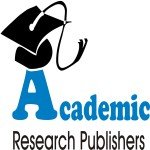Welcome to Academic Research Publishers
Academic Research Publishers is an organization dedicated to publish academic research in all disciplines. Academic Research publications are double blind peer-reviewed print journals which currently publishes journal on Business & Management ISSN : 2227-1287 (Print), Economics & Finance ISSN : 2227- 6254 (Print), Engineering Sciences ISSN : 2414-6242 (Print), Medical Sciences ISSN : 2413-8304 (Print).
As a player in the field of Academic Research publication, it aims to be a significant contributor to academic research activities in this digital era. We recognize that traditional print journals have some disadvantages, such as higher costs, paper consumption, low efficiency and limitation for distribution, while online journals are more efficient, cost less and are environmentally friendly. We believe digital scholarly journals are the trend for Academic Research publications. We try to minimize the time taken for publication and we assure you that quality articles will be published with in minimum time duration and we have also take steps to send you the editorial report within a week of your submission. So the uniqueness in Academic Research publication is less time, less cost, High impact and easy access.
Journals
-
International Academic Research Journal of Economics and Finance
International Academic Research Journal of Economics and Finance (IARJEF) - ISSN : 2227-6254 (Print)
International Academic Research Journal of Economics and Finance (IARJEF) is a Double-blind peer-reviewed quarterly journal, published by Academic Research Publishers. The journal publishes research papers in the fields of Economics , Finance, Business, Marketing, Human resource management and relevant subjects. The journal is available only on print edition and the current issue can be viewed online. Authors can also download current article from online version.
-
International Academic Research Journal of Business and Management
Impact Factor - 68.16 (ICV) 2015
International Academic Research Journal of Business and Management (IARJBM) is a Double-blind peer-reviewed quarterly journal, published by Academic Research Publishers. The journal publishes research papers in the fields of business, management, marketing, finance, economics, human resource management and relevant subjects. The journal is available only on print edition and the current issue can be viewed online. Authors can also download current article from online version.

